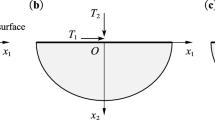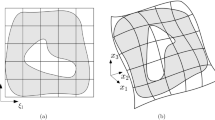Abstract
In this article, we present a new method for the generation of surface meshes of biological soft tissue. The method is based on the deformable surface model technique and is extended to histological data sets. It relies on an iterative adjustment towards polygonal segments describing the histological structures of the soft tissue. The generated surface meshes allow for the construction of volumetric meshes through a standard constrained Delaunay approach and, thus, for the application in finite element methods. The geometric properties of volumetric meshes have an immediate influence on the numerical conditioning and, therewith, on the stability of the finite element method and the convergence of iterative solvers. In this article, the influence of the surface meshes on the quality of the volumetric meshes is analysed in terms of the spectral condition number of the stiffness matrices, which are assembled within Newton’s method. The non-linear material behavior of biological soft tissue is modeled by the Mooney–Rivlin material law. The subject is motivated by the requirements of virtual surgery.







Similar content being viewed by others
References
Almeida ES, Spilker RL (1998) Finite element formulations for hyperelastic transversely isotropic biphasic soft tissues. Comput Methods Appl Mech Eng 151(3–4):513–538
Bern MW, Eppstein D (1992) Mesh generation and optimal triangulation. In: Du DZ, Hwang FKM (eds) Computing in euclidean geometry. Lecture notes series on computing, No. 1. World Scientific, Singapore, pp 23–90
Bern M, Plassmann P (2000) Mesh generation. Handbook of computational geometry. Elsevier Science, Amsterdam, pp 291–332
Canga ME, Becker EB (1999) An iterative technique for the finite element analysis of near-incompressible materials. Comput Methods Appl Mech Eng 170(1–2):79–101
Chen J, Satyamurthy K, Hirschfelt L (1994) Consistent finite element procedures for nonlinear rubber elasticity with a higher order strain energy function. Comput Struct 50(6):715–727
Cohen LD (1991) On active contour models and balloons. Comput Vis Graph Image Process Image Understanding 53(2), 211–218. http://citeseer.ist.psu.edu/cohen91active.html
Cohen LD, Cohen I (1993) Finite element methods for active contour models and balloons for 2d and 3d images. IEEE Trans Pattern Anal Mach Intell 15(11):1131–1147 http://citeseer.ist.psu.edu/cohen91finite.html
Crisfield M (1997) Nonlinear finite element analysis of solids and structures, vol 2. Advanced topics. Wiley, Chichester
Frey PJ (2000) Mesh generation. Hermes Science Europe Ltd, Oxford
Fuchs H, Kedem ZM, Uselton SP (1977) Optimal surface reconstruction from planar contours. Commun ACM 20(10):693–702
George PL (1991) Automatic mesh generation. Application to finite element methods. Wiley, New York
Golub G, Van Loan CF (1996) Matrix computations, 3rd edn. The Johns Hopkins University Press, Baltimore, MD, xxvii+694 pp. 36.00/pbk; 78.00/hbk
Hackbusch W (1996) Theorie und Numerik elliptischer Differentialgleichungen. Teubner, Stuttgart
Jankovich E, Leblanc F, Durand M, Bercovier M (1981) A finite element method for the analysis of rubber parts, experimental and analytical assessment. Comput Struct 14:385–391
Johnson A, Quigley C, Freese C (1995) A viscohyperelastic finite element model for rubber. Comput Methods Appl Mech Eng 127(1–4): 163–180
Kass M, Witkin A, Terzopoulos D (1987) Snakes: sctive contour models. Int J Comput Vis 1(4):321–331
Kikuchi N, Oden J (1988) Contact problems in elasticity: a study of variational inequalities and finite element methods. SIAM Studies in Applied Mathematics. SIAM, Society for Industrial and Applied Mathematics, Philadelphia
Le Tallec P (1994) Numerical methods for nonlinear three-dimensional elasticity. In: Ciarlet PG (ed) et al., Handbook of numerical analysis, vol III. Techniques of scientific computing (Part 1). Numerical methods for solids (Part 1). Solution of equations in \({{\mathbb{R}}}^n\) (Part 2). North-Holland, Amsterdam, pp 465–622
Leroy B, Herlin I, Cohen LD (1996) Multi-resolution algorithms for active contour models. In: 12th International conference on analysis and optimization of systems, pp 58–65
Limbert G, Middleton J (2004) A transversely isotropic viscohyperelastic material: application to the modeling of biological soft connective tissues. Int J Solids Struct 41(15):4237–4260
Martins J, Pires E, Salvado R, Dinis P (1998) A numerical model of passive and active behavior of skeletal muscles. Comput Methods Appl Mech Eng 151(3–4):419–433
Martins P, Natal Jorge R, Ferreira A (2006) A comparative study of several material models for prediction of hyperelastic properties: application to silicone-rubber and soft tissues. Strain 42:135–147
Park JY, McInerney T, Terzopoulos D, Kim MH (2001) A non-self-intersecting adaptive deformable surface for complex boundary extraction from volumetric images. Comput Graph 25:421–440
Peng SH, Chang WV (1997) A compressible approach in finite element analysis of rubber-elastic materials. Comput Struct 62(3):573–593
Rueter M (2003) Error controlled adaptive finite element methods in large strain hyperelasticity and fracture mechanics. Inst. fr Baumechanik und Numerische Mechanik, Hannover
Schroeder J, Neff P (2003) Invariant formulation of hyperelastic transverse isotropy based on polyconvex free energy functions. Int J Solids Struct 40(2):401–445
Shewchuck JR (1997) Delaunay refinement mesh generation. Dissertation, Carnegie Mellon University
Si H (2008) Tetgen. http://tetgen.berlios.de
Si H, Gaertner K (2005) Meshing piecewise linear complexes by constrained delaunay tetrahedralizations. Proceedings of the 14th international meshing roundtable, pp 147–163
Tabaddor F (1987) Rubber elasticity models for finite element analysis. Comput Struct 26:33–40
Teschner M, Heidelberger B, Mueller M, Pomeranets D, Gross M (2003) Optimized spatial hashing for collision detection of deformable objects. In: Proceedings of vision, modeling, visualization. http://citeseer.ist.psu.edu/teschner03optimized.html
Tetgen (2007) A quality tetrahedral mesh generator. http://tetgen.berlios.de
Van Loocke M, Lyons C, Simms C (2004) The three-dimensional mechanical properties of skeletal muscle: experiments and modelling. In: Prendergast et al (ed), Topic in bio-mechanical engineering. Trinity Centre for Bioengineering & National Centre for Biomedical Engineering Science
Weiss JA, Maker BN, Govindjee S (1996) Finite element implementation of incompressible, transversely isotropic hyperelasticity. Comput Methods Appl Mech Eng 135(1–2):107–128
Xu C (1999) Deformable models with application to human cerebral cortex reconstruction from magnetic resonance images. Ph.D. Thesis, John Hopkins University, Maryland (Director: Jerry L. Prince)
Xu C, Prince J (2000) Global optimality of gradient vector flow. http://citeseer.ist.psu.edu/xu00global.html
Acknowledgements
The authors would like to thank Karl Meller, Philipp Geis, Katrin Wernstedt and Anja Wilde for processing the tissues as well as Christoph Ewerlin and Olaf Schulz for their assistance in implementing code. This work was kindly supported by the HOMFOR Forschungsförderung 2008, Homburg Saar, Germany.
Author information
Authors and Affiliations
Corresponding author
Rights and permissions
About this article
Cite this article
Weichert, F., Schröder, A., Landes, C. et al. Computation of a finite element-conformal tetrahedral mesh approximation for simulated soft tissue deformation using a deformable surface model. Med Biol Eng Comput 48, 597–610 (2010). https://doi.org/10.1007/s11517-010-0607-0
Received:
Accepted:
Published:
Issue Date:
DOI: https://doi.org/10.1007/s11517-010-0607-0




